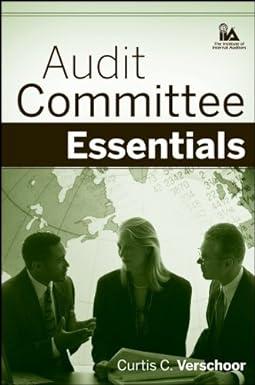Question
Corporate Social Responsibility is defined as: A. A concern for the impact of a business's actions on society as a whole. B. A code that
Corporate Social Responsibility is defined as:
| A. | A concern for the impact of a business's actions on society as a whole. | |
| B. | A code that helps in dealing with confidential information. | |
| C. | A process required by the Security and Exchange Commission (SEC). | |
| D. | Requires that all businesses conduct social audits. | |
| E. | Is mandated by the federal government. |
Generally Accepted Accounting Principles (GAAP):
| A. | Focus on the review of a situation. | |
| B. | Do not require financial statements. | |
| C. | Never change. | |
| D. | Intend to make information on the financial statements relevant, reliable, and comparable. | |
| E. | Are used to oversee the Security and Exchange Commission. |
The owners of a partnership :
| A. | Have created an entity that can also be called a sole proprietorship. | |
| B. | Have unlimited liability for debts of the business. | |
| C. | Must have a written partnership agreement in order to be legal. | |
| D. | Have created a legal organization separate from its owners. | |
| E. | Are called shareholders. |
Net income:
| A. | Decreases equity | |
| B. | Represents the amount of assets owners put into a business | |
| C. | Equals assets minus liabilities. | |
| D. | Is the excess or shortfall of revenue less expenses. | |
| E. | Represents the owners' claims against assets after all liabilities are satisfied. |
Source documents:
| A. | Must be in electronic form | |
| B. | Are the origins of recording economic accounting information | |
| C. | Are optional when entering an accounting transaction if they can be obtained if needed | |
| D. | Include the chart of accounts |
A record of all the increases and decreases in a specific, single asset, liability, or equity account is a(n):
| a. | Journal | |
| b. | Posting | |
| c. | Trial Balance | |
| d. | General Ledger Account | |
| e. | Chart of account |
Unearned revenues and prepaid expenses are used to enter accounting transactions where:
| A. | Payment will be received in cash or paid in cash in the future. | |
| B. | Payment was received in cash before performing work, or cash was paid in advance of having work performed. | |
| C. | The transaction will effect the Income Statement at the time it occurs. | |
| D. | None of the above. |
What do Dividends, Assets, and Expense accounts have in common?
| a. | They all appear on the Income Statement. | |
| b. | They all appear on the Balance Sheet. | |
| c. | They all increase their balance with a debit. | |
| d. | They all increase their balance with a credit. | |
| e. | They have nothing in common. |
Step by Step Solution
There are 3 Steps involved in it
Step: 1

Get Instant Access to Expert-Tailored Solutions
See step-by-step solutions with expert insights and AI powered tools for academic success
Step: 2

Step: 3

Ace Your Homework with AI
Get the answers you need in no time with our AI-driven, step-by-step assistance
Get Started


